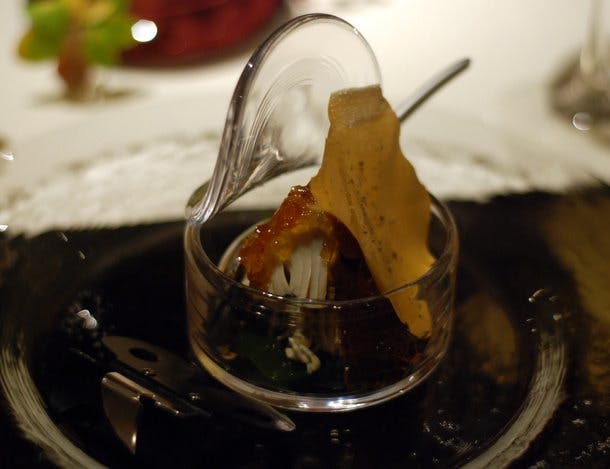
ryu gin: next wave japanese gastronomy
Discover the unique culinary artistry of Seiji Yamamoto, a Japanese chef renowned for his astonishing fusion of traditional Japanese cooking with high-tech techniques, creating a delightful blend of kaiseki and molecular gastronomy. Explore his renowned 26-seat restaurant, Ryu Gin, offering fine dining experiences that beautifully weave together traditional Japanese ingredients and cooking methods with innovative and playful presentations.
Seiji Yamamoto is a classically trained Japanese chef who prepares astonishing Japanese cooking that is nothing like the Japanese cuisine I've encountered. I saw him give a video presentation in New York last month and was blown away. His food struck me as kaiseki-meets-molecular-gastronomy, mad science from Fernan Adria's Tokyo love child, dazzlingly creative, utterly fascinating -- and, yet, food that seemed as intrinsically Japanese as a hearty bowl of shoyu ramen. Above all, Seiji's cooking looked delicious. So I had to learn more.
I got my chance this week in Tokyo (I'm in Japan now). Seiji invited me to visit his kitchen at his 26-seat Roppongi district restaurant, called Ryu Gin. I expected counters packed with lab gear and stainless steel buckets billowing with liquid nitrogen smoke. What I saw were ten cooks working in the tight space, simmering dashi on the stovetop, shaving katsuo bushi, and gutting a freshly slaughtered two-foot long hamo eel, its toothy snout spiked to a cutting board, muscles still quivering beneath its silver skin. In other words, traditional Japanese fine cooking. Seiji, who is 37 years old and has cooked for 18 of them, stood to the side observing his team. A gracious man with a gentle smile, he wore a chef coat with oversize red buttons and a Japanese flag sewn over the right breast, a chef coat that dropped down to mid-thigh like an artist's smock. So where was the molecular gastronomy?
That comes later, Seiji assured me. He explained that his approach is to build on a solid foundation of Japanese cuisine, then layer on other -- high tech -- techniques to achieve what his imagination conjures up.
What his imagination conjured was delicious, layered, complex, fragrant, breathtaking -- and hilarious. Dinner was a ten course tasting menu paired with two champagnes, a Mersault, a Burgundy and two unbelievable sakes from a tiny brewery in Fukushima prefecture. His restaurant was elegant, hushed and white tableclothed. But Seiji's cooking needled any "temple of fine dining" pretensions: Burdock root arrived shaped like a wine cork branded "Château Ryugin;" citrus infused "ice" and a "pearl" rested atop an oyster on the half-shell; abalone and clam were served in a clear glass vessel shaped like a half opened tuna can, with a real can opener by its side; a frozen "apple" cracked open to spill a power derived -- somehow -- from apple pie. The food was remarkable, fun -- but also fundamentally Japanese. Seiji devotion's to his ingredients (the maitre'd explained not only the provenance of his fish, but what said fish were eating before caught), his cooking in the moment, his deft execution all attested to that.
After dinner I returned to the kitchen. This time liquid nitrogen smoke indeed billowed from a stainless steel bucket. His goal, Seiji told me, is to expand what it means to cook Japanese cuisine. As we were talking I thought how his chef coat said it all. A Japanese flag on an artist's smock.
